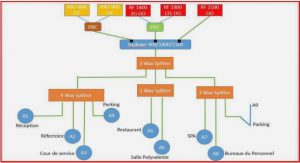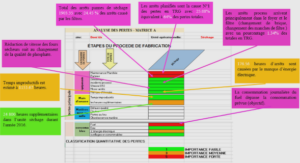History of piezoelectridty
The piezoelectric effect was first discovered in 1880 by Pierre and Jacques Curie who demonstrated that when a stress field is applied to certain crystalline materials, an electrical charge is produced on the material surface. Their experiments led them toelaborate the early theory of piezoelectricity. The first applications of the piezoelectricity appeared during the First W orld W ar with the sonar in which piezoelectric quartz was used to produce ultrasonic waves (P. Langevin) as sensors. W.G. Cady, an American physicist, proposed the use of quartz to control the resonance frequency of oscillators. It is during the period following the First World War that most of the piezoelectric applications we are now familiar with (microphones, accelerometers,ultrasonic transducers, benders … ) were conceived. However, the materials available at that time often limited deviee performance, the development of electronics, especially during the Second World War, and the discovery of ferroelectric ceramics increased the use of piezoelectric materials. Piezoelectric materials belong to a class of dielectrics, which exhibit signi:ficant material deformations response to an applied electric field and produce dielectric polarization in response to mechanical strains. In current technology, poling an appropriate substrate through the application of a large electric field at high temperatures can create piezoelectric sensors and actuators. Substrates for the process are chosen to have a crystalline, ceramic or polymerie lattice structure in which the atomic structure along at least one axis differs from that in the remaining coordinates; bence the material is anisotropie and typically orthotropic. Poling has the effect of partially aligning the polar axes of the domains to yield a macroscopic polarization, which facilitates the electromechanical coupling. As a result of this coupling, the piezoelectric material will deform in response to an applied electric field. Therefore, it gives the material its actuating properties. The sensing capabilities come from the converse effect in which the mechanical stresses in the materials cause rotations ofthe partially aligned dipoles to generate an electric field. The direct piezoelectlic effect consists of the ability of certain crystalline materials (i.e. ceramics) to generate an electrical charge in proportion of an externally applied force. The direct piezoelectric effect has been widely used in transducers design (accelerometers, force and pressure transducers … ). According to the mverse piezoelectric effect, an electric field induces a deformation of the piezoelectric material. The inverse piezoelectric effect, an electric field induces a deformation of the piezoelectric material. The inverse piezoelectric effect has been applied in actuator design.
Smart materials and structures
The application of adaptive structure technology at the present time is at the researchand development stage, as depicted by this brief survey. However, when the technology reaches a mature stage, applications could span the aeronautical, aerospace and ground transportation fields. Aeronautical applications could include attenuation of dynamic loads by means of an active wing fuselage interface or an active wing -engine pylon;flutter vibration suppression by means of adaptive wing camber and active internai cockpit noise cancellation. In aerospace system, such as the proposed space station and other large truss space structures with high performance requirements using length adjustable active truss members can attain vibration control. Another potential application would be in the realization of space structures with precise shapes, such as space antennas of high frequency range and solar collectors. Noise and vibration from the motor, road roughness and wind heavily affect ground vehicles. There are different options for noise and vibration reduction. The most conventional method is to integrate passive damping materials, which unfortunately entails additional weight. A more sophisticated way is the use of anti-noise loudspeakers in the passenger compartment or in the exhaust system and the use of additional rotating shafts integrated in the motor unit, compensating for the second-order harmonie loads particularly active as a vibration source in engines. Other possible applications include vibration and noise reduction by an active control of motor suspension systems, attenuation of noise radiation by actively controlling the vibrations of the roof sheets and the splash board, and noise and vibration control by means of an adaptively controlled suspension system. Flexible structures are widely used in space applications such as potential solar power satellites, large antennas, and large space robots as well as terrestrial applications such as high-speed robots, large bridges, and others (Ashley (1995), Barrett (1994), Khorrami (1994), Preurnont (1990), Umland (1990)). recent years, there has been an increasing interest in the development of lightweight smart or intelligent structures for space applications to control distortions caused by the effects of out space.
Sensors
Piezoelectric sensors use the same type of materials described for use as actuators. The operation of these transducers is essentially a reversible process. They can act as sensors by producing a voltage change in response to deformation. In particular, piezopolymersmake excellent sensors due to their low modulus and weight, and they can easily be shaped into much geometry, which allow for flexible and unobtrusive use in many sensing applications. Strain Gages are simple and inexpensive sensors, and represent a mature technology. Since they are discrete deviees, they may be difficult to embed in a composite type structure. This problem can be overcome by producing a thin film with gages printed on it at regular intervals. And subsequently, bonding it to the wall of a structure during the manufacturing process. Fiber Optics make excellent sensors because they are immune to the electromagnetic interference which eliminates costly and heavy shielding that is necessary to support electrical sensors. Additionally, they can be made extremely small and can be embeddedinto composite materials without structural degradation. The inherent high bandwidth of fiber optic sensors and the data links supporting them enable the potential of systems with a large number of sensors. Finally, because of the high melting point of these fi bers and the high inherent strength of glass, they are able to perfonn environments at high temperatures, vibrations and shocks loading.
Poiarization
A material that can be polarized under an electrical field is called a dielectric. Polarizability is a property inherent in ali dielectrics Heyliger (1986). One type is electronic polarization, caused by shifts in electron clouds of the material away from their equilibrium position for an applied field. Polar materials have additional contributions to the material polarizability from orientation polarization of the dipoles for an applied electric field. In all cases, application of the electric field to the dielectric material induces a volume of polarization. The field created in the materials is offset by additional charges, which have collected on the electrodes. Thus, the dielectric constant is used as a measure of the charge storage capacity of the material.
Simple beam theory
The bearn depicted in Figure 3, is assumed to have length L, width b, thickness h and cantilever end conditions with the fixed end at x = 0 and free at x = L. It is assumed that the bearn is homogeneous and constructed from a material, which essentially satisfies the Euler-Bernoulli hypothesis for displacement. Finally, it is assumed that a number n pair of identical piezoelectric is bonded to opposite sides of the bearn. The Y oung’s modulo, linear mass density for the bearn and the piezoelectric are given in Table II. The bonding layer is taken to be negligible. this section, a detailed formulation of the bearn vibration due to partially covered surface -bonded piezoelectric is presented. This cantilever bearn is subdivided into five spanwise regions, namely, two composite (aluminium bearn bonded with piezo-actuator materials) regions and three simple (aluminium bearn) regions. Each segment of cantilever bearn (Figure 3) is modelled as an Euler-Bernoulli bearn. The solution for the bearn as a whole is obtained in terms of the solutions of the entire component EulerBernoulli beams by satisfying the appropriate boundary conditions and continuity conditions.
|
Table des matières
ABSTACT
SOMMAIRE
RÉSUMÉ
ACKNOWLEDGEMENTS
TABLE OF CONTENTS
LIST OF TABLES
LIST OF FIGURES
INTRODUCTION
CHAPTER 1 BACKGROUND
1.1 His tory of piezoelectricity
1.2 Review of literature
1.2.1 Smart materials and structures
1.2.2 Actuators
1.2.3 Sensors
1.2.4 Vibration control
1.2.5 Mode ling
1.2.6 Polarization
1.2. 7 Piezoelectricity
1.2.8 Shape estimation
CHAPTER 2 MODELING OF ALUMINIUM BEAM WITH PIEZOELECTRIC
2.1 Introduction
2.2 Piezoelectric fini te element formulation
2.2.1 Equilibrium Equations
2.2.2 Constitutive Relationships
2.3 Analytical model
2.3.1 Analytical procedures
2.3.2 Simple bearn theory
2.3.3 Modal Analysis
2.3.4 Static Analysis
2.4 Experimental approach
2.5 Results and comparison
2.5.1 Exarnple 1
2.5.2 Example 2
2.6 Summary
CHAPTER 3 MODELING OF LAMINATED BEAM WITH PIEZOELECTRIC
3.1 Introduction
3.2 Problem statement
3.3 Transverse vibration oflarninate bearn
3.3.1 Static analysis
3.3.2 Modal analysis
3.4 Nmnerical approach
3 .4. 1 Assumed -modes method
3.4.2 Finite element method
3. 5 Results and comparisons
3.6 Smnmary
CHAPTER 4 MODELING OF CIRCULAR PLATE WITH PIEZOELECTRIC
4.1 Introduction
4.2 Plate model
4.2.1 Modal Analysis
4.2.2 Boundary and joint conditions
4.3 Energy method
4.3.1 Strain energy
4.3 .2 Kinetic Energy
4.3.3 Electric energy
4.4 Lagrange’s equation
4.4.1 Equation ofMotion
4.5 Model for vibration control
4.5 .1 Assumed-modes method
4.5.2 Plate
4.3.3 Actuator
4.5.4 Mass, stif:fuess and load vector extraction
4.6 Experimentation
4. 7 Results and comparisons
4. 7.1 Obtaining matrices using assume mode model
4.7.2 Obtaining matrices using super-element
4.8 Summary
CHAPTER 5 SHAPE ESTIMATION OF STRUCTURES
5.1 Introduction
5.2 Model for rectangular plate
5.2.1 Assumptions
5.2.2 Method
5.2.3 Least Squares Method
5.3 Model for circular plate
5.3.1 Description
5.3.2 Method
5.3.3 Application
5.3.3.1 Axisyrnmetric problem
5.3 .3.2 Quasi axisyrnmetric problem
5.3.3.3 General case
5.5 Experimentation
5.5 Results and comparison
5.5.1 Rectangular plate
5.5.2 Circular plate
5.6 Summary
CONCLUSION
APPENDIX 1 CONTRIBUTIONS TO RESEARCH AND DEVELOPMENT
BIBLIOGRAPHY
![]() Télécharger le rapport complet
Télécharger le rapport complet






